When I said that the best of the current crop of Craft Beer Cookbooks was the Canadian one, I should point out that it’s not out of bias. I mean, for one thing, I’m Canadian and it’s always nice when we win something. I also know the author, David Ort, so you might be inclined to see me as favouring the book for that reason. I can assure you that this is not the case, nice man though he may be.
The other two books are The American Craft Beer Cookbook: 155 Recipes from your Favorite Brewpubs and Breweries and The Craft Beer Cookbook: From IPAs and Bocks to Pilsners and Porters, 100 Artisanal Recipes for Cooking with Beer by John Holl and Jacquelyn Dodd respectively. Both of these books have their strengths as well.
In the case of John Holl’s book, he’s curating recipes from other sources and picking the best ones for you. I did notice that there are a number of recipes where the beers might be quite hard to find locally depending on what part of the country you’re in. This is, of course, something that provides some of the attraction for the set of recipes he has chosen. You would likely be able to make the food with a different beer and still have it feel like it was from a brewpub in San Diego or Kenosha or Butte. I don’t know that there is a cuisine specific to Butte, but it seems like ranching country.
There are a few recipes, though, where (I seem to remember) they talk about using a very specific product in the recipe that’s available at the brewpub or brewery’s website (it might have been a root beer bbq sauce.) I read it a couple of months ago, so I hope that I’m not misrepresenting it. I feel that if you can’t replicate the entire recipe given a couple hours of shopping, it’s probably not cricket. There’s no need to involve Fedex in a delicious meal.
Still, the ideas are good and the book is attractively presented and my quibbles as listed are relatively minor. It’s a good job of work.
In the case of Jacquelyn Dodd’s book, there are some quite good recipes. I quite like the look of the Porter, Goat Cheese and Portobello Mushroom Stuffed Pork Loin and I confess I’ll be trying the White Bean and Beer Chicken Chili just as soon as it gets to be slow cooker weather. IPA watermelon ceviche seems like a winner. Dodd has sidestepped the regionality issue in a craft beer cookbook by not suggesting specific brands of beer for each recipe, deciding rather to chip in periodically with “try this with a woody IPA” or “a malty stout with notes of chocolate and espresso.” That’s fine, although it can be hard to picture what a recipe would taste like without substituting in a beer of your choice mentally while reading. It’s preferable to the alternative where it specifies a beer you’ve never tasted and can’t lay hands on.
The only real problem I have is that a number of the recipes seem to involve straight volume substitutions of beer for another liquid. There’s a scratch made Cavatelli pasta that more or less substitutes beer for water or egg yolk. There are Corn Tortillas with regular Masa Harina, but instead of another liquid: beer. That’s fine as far as it goes, but why it’s happening isn’t really sufficiently explained. I feel like a number of the recipes would have benefitted from a little more conversation with the reader. I’d have gladly given up 20 of the 100 recipes for a better sense of purpose.
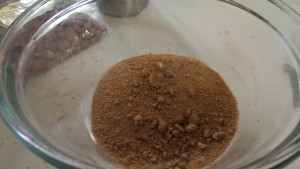
If you’re like me and you have forgotten adequately to seal your brown sugar after last time you had oatmeal for breakfast, it is probably lumpy.
Besides, I don’t really like straight volume replacement as a tool. I like it when there’s a flavourful beer getting used as a balanced ingredient in the equation. For that reason, I got the nice people over at Whitecap books to send over a .doc file that contains the recipe for the Smoky Maple Beer Nuts from the Canadian Craft Beer Cookbook. Google Chrome should let you open it in a separate tab. Let’s have a look at this and see how it works.
This is about a two hour cooking process, but it’s probably only 15 minutes of actual work. A word on assembling ingredients for the recipe. If you’re going to go to the trouble of making your own beer nuts, you’re probably in for a pound. You can buy beer nuts for basically the price of whatever nut you purchase for this recipe. They probably won’t be as good and they certainly will not give you a sense of pride or the ability to make silly double entendre jokes. I chose to go with almonds because I like almonds, although there was a period where I stared questioningly at a bag of walnuts.
If you’re going to make this, you need real maple syrup. Don’t throw maple flavoured syrup on there. You might fool your guests, but deep down you’ll know. You’ll know and it will haunt you.
Actually, considering the size of the containers that maple syrup, cayenne pepper and Church Key Holy Smoke come in and the small amounts used in the recipe, the best thing to do is triple the recipe and buy about three pounds of almonds and spend an afternoon making a snack that you can put out when you’re entertaining throughout the holiday season.
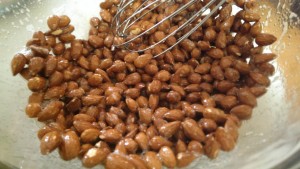
It’s not really adequately explained in the recipe, but toss the almonds in the wet ingredients then, once coated, add the dry ingredients and toss again. Pause briefly to marvel at the fact you own a whisk despite being unable to remember the purchase.
The reason I like this recipe is because Church Key Holy Smoke really does contain enough peat character to add to the final flavour of the beer nuts, but not quite enough to be recognizable as itself. You could probably bolster the smoke by adding a little paprika to the cayenne in the blended dry ingredients. As it stands, there’s just a hint of smoke and maple in the mixture. It’s clever because for he’s actually using the 20ml of beer as an additional spice that blends in with the cayenne.
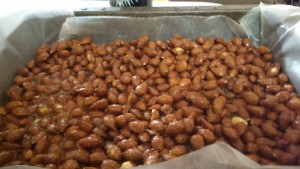
Line a cookie sheet or baking tray with parchment paper. I was also shocked that I owned parchment paper. No measuring spoons, but parchment paper.
A lot of the Canadian Craft Beer Cookbook recipes use beer in that fashion, and since that’s very much the way I think about beer and food, I’m excited about trying more of the recipes out. I don’t think I’ve been this excited about getting a cookbook since I got Rick Bayless’ comprehensive Mexican one.
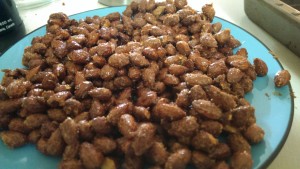
When the nuts are done, you want to put them on a plate to cool. For the love of god, don’t go putting the hot salty nuts directly into your mouth. You will burn the dickens out of the roof of your mouth. Also, probably don’t go grabbing them barehanded for the first twenty minutes after they come out of the oven.
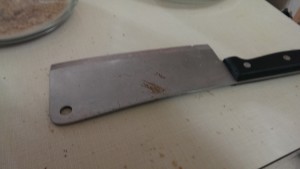
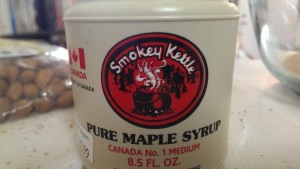
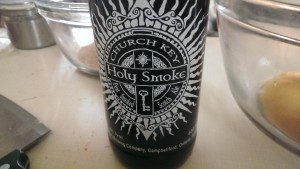
Thanks for writing about my book, Jordan, and glad the nuts recipe worked out for you.
I did tune this recipe so that the cayenne and smoke would be at a balanced, flavourful, but subtle level. I’ll be happy to see people turn those knobs up if they like those particular flavours.
In this case, I like the idea of smoked paprika for more smokiness. A 1/4 to 1/2 teaspoon of liquid smoke would also do the job. (Good quality versions are just distilled smoke and frankly no more chemical-ridden or hazardous than actual woodsmoke.)
For the Sweet and Sour Beer Nuts recipe (on the page before the one for the Maple Smoky Beer Nuts), the sichuan peppercorns and cayenne can also be turned up by a factor of two or three without doing any harm
Hey, Jordan: the Word document says there are supposed to be two recipes. Sweet and Sour Beer Nuts sounds good!
I’m sure it does! This would be an excellent time to pre-order your copy from Amazon.ca! Hooray for reading stuff and learning things!
Actually, there’s a lot of good stuff in there. Soba Noodles with Schwarzbier looks super.
Snoop dogg reference in the title?